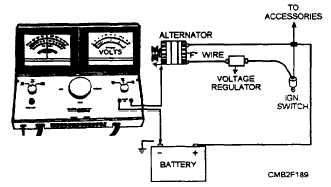There are two common circuit resistance tests - insulated resistance test and ground circuit resistance test.
INSULATED RESISTANCE TEST. - To perform an insulated resistance test, connect the load tester as described by the manufacturer. A typical connection setup is shown in figure 2-35. Note how the voltmeter is connected across the alternator output terminal and positive battery terminal.
With the vehicle running at a fast idle, rotate the load control knob to obtain a 20-amp current flow at 15 volts or less. All accessories and lights are to be turned OFF. Read the voltmeter. The voltmeter should NOT read over 0.7-volt drop (0.volt per electrical connection) for the circuit to be considered in good condition. However, if the voltage drop is over 0.7 volt, circuit resistance is high and a poor electrical connection exists.
GROUND CIRCUIT RESISTANCE TEST. - With the ground circuit resistance test the voltmeter leads are placed across the negative battery terminal and alternator housing (fig. 2-36).
The voltmeter should NOT read over 0.1 volt per electrical connection. If the reading is higher, this indicates such problems as loose or faulty connections, burnt plug sockets, or other similar malfunctions.

Figure 2-35. - Typical insulated resistance test setup.

Figure 2-36. - Typical ground circuit resistance test setup.
REVIEW 1 QUESTIONS
Q1. How many electrical circuits are in a typical automotive electrical system?
Q2. What component of the charging system produces and stores electricity?
Q3. What substance is contained in apositiveplate of a filly charged battery?
Q4. What type of gas collects at the top of a battery?
Q5. What is the specific gravity of a fully charged battery?
Q6. What are the two methods of rating lead-acid storage batteries?
Q7. When mixing electrolyte, you should follow what rule?
Q8. What battery test will determine if current is discharging across the top of the battery?
Q9. You are performing a battery drain test using an ammeter. What should the meter read with everything in the vehicle turned off?
Q10. When performing a quick charge test, you should charge the battery at 30 to 40 amps for what minimum time period?
Q11. What are the two types of field circuits used in dc generators?
Q12. What are the three design factors that determine the output of a dc generator?
Q13. What two tests are used for locating shorts in the armature of a dc generator?
Q14. What component of the alternator contains the heat sink the diodes, the diode plate, and the electrical terminals?
Q15. What type of alternator stator is used in high output alternators?
Q16. How is alternator output reduced using an electronic voltage regulator?
Q17. What is the most common type of voltage regulator used on modern vehicles?
Q18. What charging system test measures the charging systems voltage, under low output, low load conditions?
Q19. What two testing devices are used to perform a charging system test?
Continue Reading